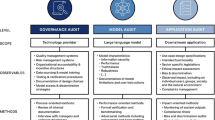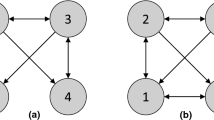Abstract
In many cases several entities, such as commercial companies, need to work together towards the achievement of joint goals, while hiding certain private information. To collaborate effectively, some sort of plan is needed to coordinate the different entities. We address the problem of automatically generating such a coordination plan while preserving the agents’ privacy. Maintaining privacy is challenging when planning for multiple agents, especially when tight collaboration is needed and a global high-level view of the plan is required. In this work we present the Greedy Privacy-Preserving Planner (GPPP), a privacy preserving planning algorithm in which the agents collaboratively generate an abstract and approximate global coordination plan and then individually extend the global plan to executable plans. To guide GPPP, we propose two domain independent privacy preserving heuristics based on landmarks and pattern databases, which are classical heuristics for single agent search. These heuristics, called privacy-preserving landmarks and privacy preserving PDBs, are agnostic to the planning algorithm and can be used by other privacy-preserving planning algorithms. Empirically, we demonstrate on benchmark domains the benefits of using these heuristics and the advantage of GPPP over existing privacy preserving planners for the multi-agent STRIPS formalism.




Similar content being viewed by others
Notes
The exact details of this relaxed problem are more involved, and are explained later in the paper.
When computing the achievers of p, only actions that can be performed before obtaining p are considered. This is usually estimated using delete relaxation [39].
We also experimented with using the A* [23] algorithm to find optimal plans for the PDB. Experimentally, we did not observe a substantial difference between the performance of the two algorithms for solving these simple single fact problems.
In the results in the previous tables, the averages were over a subset of these instances, as other planning algorithm/heuristic configurations did not solve all problem instances under the time limit.
References
Albore, A., Palacios, H., & Geffner, H. (2009). A translation-based approach to contingent planning. In IJCAI 2009, Proceedings of the 21st International Joint Conference on Artificial Intelligence, Pasadena, CA, USA, July 11-17, 2009 (pp. 1623–1628).
Alcázar, V., Borrajo, D., Fernández, S., & Fuentetaja, R. (2013). Revisiting regression in planning. In International Joint Conference on Artificial Intelligence (IJCAI) (pp. 2254–2260).
Bäckström, C. (1998). Computational aspects of reordering plans. Journal of Artificial Intelligence Research (JAIR), 9(1), 99–137.
Bernstein, D. S., Givan, R., Zilberstein, S., & Immerman, N. (2002). The complexity of decentralized control of Markov decision processes. Mathematics of Operations Research, 27, 819–840.
Bonet, B., & Geffner, H. (2001). Planning as heuristic search. Artificial Intelligence, 129(1), 5–33.
Boutilier, C. (1996). Planning, learning and coordination in multiagent decision processes. In the conference on Theoretical aspects of rationality and knowledge (pp. 195–210).
Boutilier, C., & Brafman, R. I. (2001). Partial-order planning with concurrent interacting actions. Journal of Artificial Intelligence Research, 14, 105–136.
Bratman, M. (1987). Intention, plans, and practical reason.
Brafman, R. I. (2015). A privacy preserving algorithm for multi-agent planning and search. In Proceedings of the Twenty-Fourth International Joint Conference on Artificial Intelligence, IJCAI 2015, Buenos Aires, Argentina, July 25-31, 2015 (pp. 1530–1536).
Brafman, R. I., & Domshlak, C. (2008). From one to many: Planning for loosely coupled multi-agent systems. In ICAPS (pp. 28–35).
Brafman, R. I., & Domshlak, C. (2013). On the complexity of planning for agent teams and its implications for single agent planning. Artificial Intelligence, 198, 52–71.
Brafman, R. I., Shani, G., & Zilberstein, S. (2013). Qualitative planning under partial observability in multi-agent domains. In Proceedings of the Conference on Artificial Intelligence (AAAI), Bellevue, WA, USA, July 14–18, 2013 (pp. 130–137).
Crosby, M., & Petrick, R.P. (2014). Temporal multiagent planning with concurrent action constraints. In ICAPS workshop on Distributed and Multi-Agent Planning (DMAP).
Crosby, M., Jonsson, A., & Rovatsos, M. (2014). A single-agent approach to multiagent planning. European Conference on Artificial Intelligence (ECAI), 263, 237.
Culberson, J. C., & Schaeffer, J. (1998). Pattern databases. Computational Intelligence, 14(3), 318–334.
Edelkamp, S. (2001). Planning with pattern databases. In the European Conference on Planning (ECP) (pp. 13–34).
Felner, A., Korf, R. E., & Hanan, S. (2004). Additive pattern database heuristics. Journal of Artificial Intelligence Research (JAIR), 22, 279–318.
Georgeff, M., Pell, B., Pollack, M., Tambe, M., & Wooldridge, M. (1999). The belief-desire-intention model of agency. In Intelligent Agents V: Agents Theories, Architectures, and Languages (pp. 1–10). Berlin: Springer.
Greenstadt, R., Grosz, B. J., & Smith, M. D. (2007). SSDPOP: Improving the privacy of DCOP with secret sharing. In AAMAS.
Grinshpoun, T., & Tassa, T. (2014). A privacy-preserving algorithm for distributed constraint optimization. In International Conference on Autonomous Agents and Multi-agent Systems (AAMAS) (pp. 909–916).
Grinshpoun, T., Grubshtein, A., Zivan, R., Netzer, A., & Meisels, A. (2013). Asymmetric distributed constraint optimization problems. Journal of Artificial Intelligence Research, 47, 613–647.
Grosz, B., & Kraus, S. (1996). Collaborative plans for complex group action. Artificial Intelligence, 86(2), 269–357.
Hart, P. E., Nilsson, N. J., & Raphael, B. (1968). A formal basis for the heuristic determination of minimum cost paths. IEEE Transactions on Systems Science and Cybernetics, 4(2), 100–107.
Helmert, M., & Geffner, H. (2008). Unifying the causal graph and additive heuristics. In ICAPS (pp. 140–147).
Helmert, M., Haslum, P., Hoffmann, J., & Nissim, R. (2014). Merge-and-shrink abstraction: A method for generating lower bounds in factored state spaces. Journal of the Alternative and Complementary Medicine, 61(3), 16.
Hoffmann, J. (2001). FF: The fast-forward planning system. AI Magazine, 22(3), 57.
Hoffmann, J. (2005). Where ’ignoring delete lists’ works: Local search topology in planning benchmarks. Journal of Artificial Intelligence Research, 24, 685–758.
Hoffmann, J., Porteous, J., & Sebastia, L. (2004). Ordered landmarks in planning. Journal of Artificial Intelligence Research (JAIR), 22, 215–278.
Jakubuv, J., Tozicka, J., & Komenda, A. (2015). Multiagent planning by plan set intersection and plan verification. ICAART 15.
Karpas, E., & Domshlak, C. (2009). Cost-optimal planning with landmarks. In IJCAI (pp. 1728–1733).
Kovacs, D. L. (2012). A multi-agent extension of pddl3.1. In Workshop on the International Planning Competition (IPC) in the International Conference on Automated Planning and Scheduling (ICAPS) (pp. 19–27).
Kovacs, D. L. (2015). Complete BNF definition of MA-PDDL with privacy. http://agents.fel.cvut.cz/codmap/MA-PDDL-BNF-20150221.pdf.
Luis, N., & Borrajo, D. (2014). Plan merging by reuse for multi-agent planning. In ICAPS workshop on Distributed and Multi-Agent Planning (DMAP).
Maliah, S., Shani, G., & Stern, R. (2014). Privacy preserving landmark detection. In the European Conference on Artificial Intelligence (ECAI) (pp. 597–602).
Nissim, R., & Brafman, R. I. (2014). Distributed heuristic forward search for multi-agent planning. Journal of Artificial Intelligence Research (JAIR), 51, 293–332.
Nissim, R., Brafman, R. I., & Domshlak, C. (2010). A general, fully distributed multi-agent planning algorithm. In International Conference on Autonomous Agents and Multiagent Systems (AAMAS) (pp. 1323–1330).
Pommerening, F., Röger, G., & Helmert, M. (2013). Getting the most out of pattern databases for classical planning. In the International Joint Conference on Artificial Intelligence, IJCAI (pp. 2357–2364).
Pynadath, D. V., & Tambe, M. (2002). The communicative multiagent team decision problem: Analyzing teamwork theories and models. Journal of Artificial Intelligence Research, 16(1), 389–423.
Richter, S., & Westphal, M. (2010). The LAMA planner: Guiding cost-based anytime planning with landmarks. Journal of Artificial Intelligence Research (JAIR), 39(1), 127–177.
Richter, S., Helmert, M., & Westphal, M. (2008). Landmarks revisited. Association for the Advancement of Artificial Intelligence, 8, 975–982.
Röger, G., & Helmert, M. (2010). The more, the merrier: Combining heuristic estimators for satisficing planning. In ICAPS (pp. 246–249).
Sondik, E. J. (1971). The optimal control of partially observable markov processes. Ph.D. Thesis, Stanford University, United States, California.
Štolba, M., & Komenda, A. (2014). Relaxation heuristics for multiagent planning. In International Conference on Automated Planning and Scheduling (ICAPS).
Štolba, M., Fišer, D., & Komenda, A. (2015). Admissible landmark heuristic for multi-agent planning. In International Conference on Automated Planning and Scheduling (ICAPS).
Štolba, M., Komenda, A., & Kovacs, D.L. (2015). Competition of distributed and multiagent planners (codmap). The International Planning Competition (WIPC-15) (p. 24).
Torreño, A., Onaindia, E., & Sapena, O. (2014). A flexible coupling approach to multi-agent planning under incomplete information. Knowledge and Information Systems, 38(1), 141–178.
Torreño, A., Onaindia, E., & Sapena, Ó. (2014). Fmap: Distributed cooperative multi-agent planning. Applied Intelligence, 41, 1–21.
Torreno, A., Sapena, O., & Onaindia, E. (2015). Global heuristics for distributed cooperative multi-agent planning. In International Conference on Automated Planning and Scheduling (ICAPS).
Tozicka, J., Jakubuv, J., & Komenda, A. (2014). Generating multi-agent plans by distributed intersection of finite state machines. In ECAI (pp. 1111–1112).
Valenzano, R. A., Sturtevant, N. R., Schaeffer, J., Buro, K., & Kishimoto, A. (2010). Simultaneously searching with multiple settings: An alternative to parameter tuning for suboptimal single-agent search algorithms. In ICAPS (pp. 177–184).
Yeoh, W., Felner, A., & Koenig, S. (2010). Bnb-adopt: An asynchronous branch-and-bound dcop algorithm. Journal of Artificial Intelligence Research, 38, 85–133.
Acknowledgments
We thank the reviewers for their useful comments. We also thank Antonin Komoda and Michal Stolba for their extensive help with running GPPP on the CoDMAP servers. This work was supported by ISF Grant 933/13, and by the Helmsley Charitable Trust through the Agricultural, Biological and Cognitive Robotics Center of Ben-Gurion University of the Negev.
Author information
Authors and Affiliations
Corresponding author
Additional information
Parts of this paper appeared as [34].
Appendix: GPPP versus MAFS on CoDMAP instances
Appendix: GPPP versus MAFS on CoDMAP instances
In this appendix we present additional results to those presented in Sect. 8.3, on a different set of problems: the problem instances used in CoDMAP for the domains Satellite, Elevators, Rover, Zenotravel, and Logistics. The purpose of these results is to compare the performance of GPPP and MAFS using the landmark projection heuristic, PP-LM, and 3PDB.
Table 8 shows the coverage results, i.e, number of instances solved under 30 min. Here too, we see a clear advantage for GPPP over MAFS, and for PP-LM over the projection landmarks (LM-Proj). Note that there is no clear winner when comparing PP-LM and 3PDB, suggesting that a combination of the two would work well.
The next set of results compares the runtime and solution cost of the different configurations. To do so, we average only over the instances solved by all the compared configurations (GPPP/MAFS, LM-Proj/PP-LM/3PDB). Since MAFS with the projection LM is unable to solve many instances, we compared it only against MAFS with PP-LM, and provide separate results where we compare MAFS with PP-LM against the other configurations to allow an average over more instances.
Table 9 shows the average runtime over the instances solved by MAFS with the projection LM heuristic and by MAFS with PP-LM, showing a clear advantage for MAFS with PP-LM. Table 10 presents the average runtime of all configurations (except for MAFS with the projection LM heuristic), where the average is over all instances solved by all configurations. Here we observe a clear advantage to GPPP over MAFS, and to 3PDB over PP-LM.
Regarding solution cost, we observe only one clear trend, which is that the solution found by MAFS with the projection-based heuristic is poorer than that with PP-LM. We did not observe a clear trend regarding the solution cost when comparing the other configurations (Tables 11 and 12).
Rights and permissions
About this article
Cite this article
Maliah, S., Shani, G. & Stern, R. Collaborative privacy preserving multi-agent planning. Auton Agent Multi-Agent Syst 31, 493–530 (2017). https://doi.org/10.1007/s10458-016-9333-9
Published:
Issue Date:
DOI: https://doi.org/10.1007/s10458-016-9333-9




